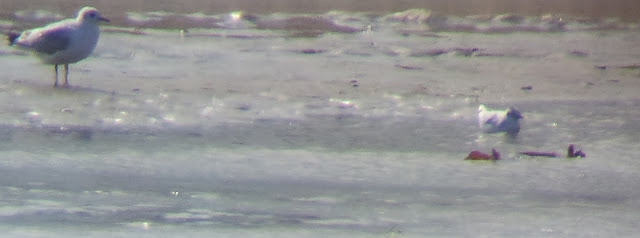Then, in a hedge at the top end of the top fields, I found a new species for me in Britain. There were at least two redstarts flitting around in the bushes. It was a superb sight, added to by a sleeping fox in the next field. We continued down the path, but there seemed to be no sign of the shrike. A group of birdwatchers described having seen it earlier, but it seemed to have disappeared.
Thankfully, after about 20 minutes of searching, the red-backed shrike appeared a very long way away in someone's garden. A great bird, but not a great view! We watched it for a short while as it moved around the bushes. It's incredible to think that this used to be a common breeding bird in Britain, with its current status reduced to a rare passage migrant.
Thankfully, after about 20 minutes of searching, the red-backed shrike appeared a very long way away in someone's garden. A great bird, but not a great view! We watched it for a short while as it moved around the bushes. It's incredible to think that this used to be a common breeding bird in Britain, with its current status reduced to a rare passage migrant.
We returned to the Observatory, stopping off in a small area of forest, hoping to find a pied flycatcher or firecrest, or anything else of interest. Besides the common finches and tits, there were several blackcaps, a reed warbler and a gardenenabler. We failed to find anything particularly uncommon around the area, but had great views of a kestrel, a fly-over siskin and several rock pipits.
On our way home, we stopped off at Ferrybridge, hoping to pick up a rare wader.
And we found one. Among the large numbers of dunlin and ringed plovers and singles or pairs of turnstones, oystercatchers, sanderling and black-tailed godwit were two curlew sandpipers. My 199th British species, and a particularly difficult species to find. There were also several wheatears and the same 6 pale-bellied brent geese I saw two weeks ago.
And we found one. Among the large numbers of dunlin and ringed plovers and singles or pairs of turnstones, oystercatchers, sanderling and black-tailed godwit were two curlew sandpipers. My 199th British species, and a particularly difficult species to find. There were also several wheatears and the same 6 pale-bellied brent geese I saw two weeks ago.
Interestingly, on the 28th the house martins in Sherborne were still visiting their nest, and there appeared to be chicks in it. An incredibly late date to be raising chicks, so it seems like these birds have been affected by the dreadful summer weather.










